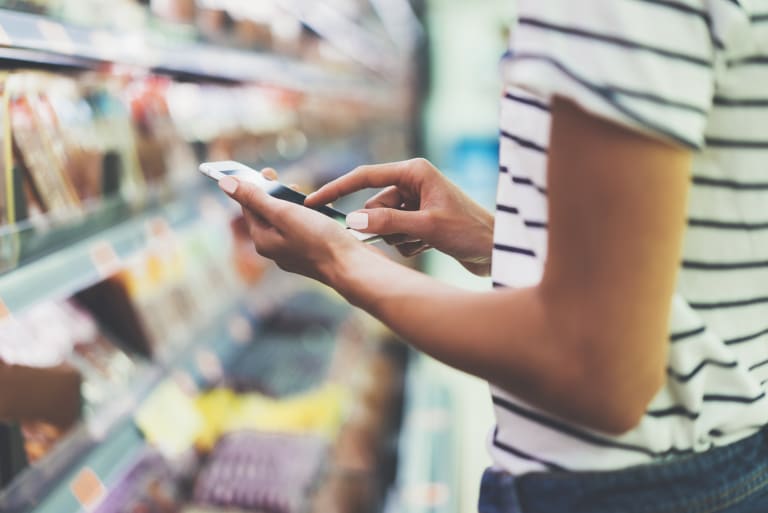Individuals with anorexia, binge eating disorder and bulimia often feel anxious and overwhelmed when surrounded by food. This anxiety can make grocery shopping and cooking a challenge.
A new form of telemedicine in which people can video-chat with a nutritional counsellor while at the supermarket aims to help.
Technology can help people recovering from an eating disorder feel more confident at the supermarket.
According to the Butterfly Foundation, it is estimated that just over 900,000 Australians suffer from an eating disorder. Of these, 47 per cent have binge eating disorder, 12 per cent have bulimia nervosa, and three per cent have anorexia.
Jamie Lynn Pelletier, 28, from North Carolina in the US, was just 13 when she began counting calories and skipping meals, behaviour that eventually led to anorexia, which is characterised by food restriction, extreme weight loss and distorted body image.
"In junior high, I began to feel unattractive and self-conscious about my body. To lose weight, I started dieting and overexercising," Pelletier said.
Since 2015, Pelletier has completed several residential and outpatient treatment programs in the battle to stop starving herself. Her struggle shows how tough it can be for anorexics to stop seeing food as the enemy.
Recently, Pelletier's dietitian recommended grocery store therapy, which allows her to connect with a dietitian via video chat.
"Going to the grocery store is stressful because seeing foods labelled as low-carb and low-fat can make me feel like buying the real thing is not OK. With virtual therapy, I FaceTime with my dietitian at the store," said Pelletier, referring to Apple's video-chat application. "For privacy, I put in my headphones so I can talk to her discreetly while I'm shopping."
This type of treatment, known as exposure therapy, allows people to face their traumas, phobias and anxieties by gradually exposing them to the feared stimulus.
"The eating disorder treatment world has adapted exposure therapy to help people face their food fears. Grocery store therapy can be beneficial by allowing individuals to confront their anxieties with the support of a trusted health-care provider," said Kelsey Latimer, a clinical psychologist at the Centre for Discovery, a treatment facility for eating disorders in Florida.
Earlier, dietitians and counsellors would accompany their clients on store outings. Telemedicine allows for virtual help. It can be a game-changer for those living in rural areas where access to health-care services may be limited, experts said.
Lois Zsarnay, a therapist and dietitian in Ventura, California, said telemedicine has expanded the support services she can offer.
"With technology like FaceTime, I can virtually accompany my clients at the grocery store, which allows me to help them at that moment with their food struggles," she said.
Zsarnay first meets with clients in person. They discuss food fears, potential anxiety triggers and treatment goals. For some, simply stepping inside the store is a huge success; others are ready to take a more significant risk by purchasing a "forbidden" food, such as ice cream, bagels or potato chips, she said.
When Zsarnay provides virtual grocery store therapy, she begins each session with a breathing exercise to help her clients feel grounded. "At first, we take a few deep breaths together, and then I remind my client about the objectives we reviewed during our planning meeting," she said. Often, clients become triggered when walking down, for example, the cereal aisle. When this fear arises, Zsarnay uses relaxation exercises to help decrease her client's anxiety. If the client becomes too overwhelmed, she reminds them that they can walk back to an area of the store with "safer" foods. Once the anxiety dissipates, she proceeds to guide her client through their shopping list.
Virtual grocery store therapy is relatively new, and there are no studies on its effectiveness. But there is some research on the effectiveness of other forms of virtual therapy to help treat eating disorders.
Athena Robinson, a clinical psychologist and eating disorders researcher at Stanford University, conducted a small study examining the effectiveness of online therapy for eating disorders. The research focused on 34 participants who connected with individual and group therapists and nutritionists through a video conference platform. Robinson and colleagues presented the study's findings at the International Conference on Eating Disorders in April.
"Our initial results show a clinically significant reduction in eating disorder symptoms," Robinson said. She added that future research will examine long-term effectiveness.
For Pelletier, virtual therapy has been a vital part of her healing.
"At the grocery store, I get uneasy reading nutrition labels because I fixate on how many calories are in each food. With grocery store therapy, my dietitian talks me through my fears and reminds me that all foods, even carbohydrates and sweets, are good foods," she said.
Pelletier completed four sessions of grocery store therapy. The treatment helped her realise that no one is judging her food choices or her appearance. Since finishing the treatment, she has been able to shop on her own.
Even though telemedicine can make aspects of eating disorder treatment more accessible, it isn't a replacement for in-person care, experts say. Pelletier continues to meet in person with a psychotherapist and a nutritionist regularly.
"It was validating for my dietitian to acknowledge my worries; it helped me to feel less alone. While recovery is a journey, grocery store therapy gave me additional tools to help guide me through the process," she said.
The Washington Post
The Butterfly Foundation 1800 33 4673
Source: Read Full Article
